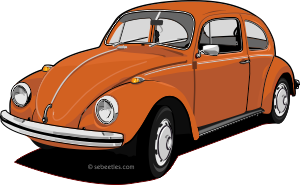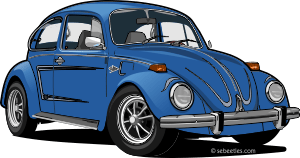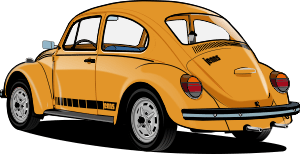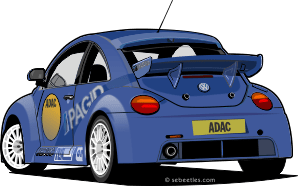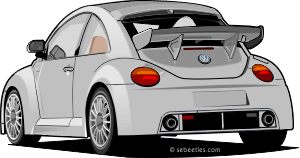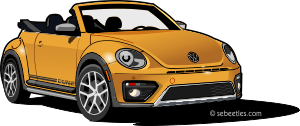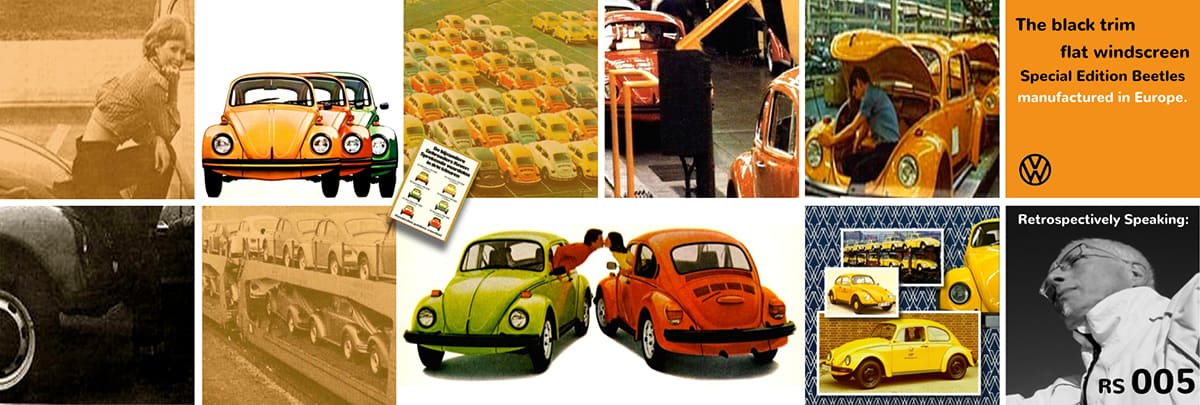Retrospectively Speaking: The black trim, flat windscreen, Special Edition Beetles manufactured in Europe.
So, continuing on from the story of black trimmed 1303 SEBs in RS 004 it is now time to look at the similarly finished flat screen models. First I would ask all readers from mainland Europe to try and appreciate that, for me, the only experience of seeing a factory fresh, new, Beetle with black trim in a dealership showroom during the 1970’s was the S761 Jeans I. It was only later that I became aware of other Jeans variations seen on holiday visits to Germany and where I fell in love at first sight with the L11C Brilliant Gelb S714 version.
Much later still, when I first encountered the SEBeetles website as a curious visitor, I was enthralled to discover that, to my delight, there were several more black trimmed Editions in addition to the Jeans models. A delight and ongoing interest that has ultimately prompted this article. But first a detour: or rather a couple of detours, en route to visiting all of the black trimmed, flat windscreen SEBs in sequence:
Detour one:
Given the volume of cars manufactured in any one single Special Edition production run the use of special paintwork colours, special trim details or upholstery material was easily viable from a commercial point of view.
One distinctive set of major components for the black trim SEB models however was already well established by the time the first SEBs adorned with such details were released in late 1972 for the 1973 model year. In fact Beetles with L062 bright yellow paintwork with black wing beading and satin black, instead of chrome, trim had been in production for quite a long time.
This, the Postkäfer, was produced for one of Volkswagen’s best, regular, customers. The Deutsche Bundespost (DBP). It used, effectively, the same base model as many of the SEB Editions covered by this article in the form of the 1200 spartan Käfer.
Volkswagen parts lists for the Beetles from the 1970s record most external trim items in both chrome and satin black version – sometimes linked to “S” series models. But the pattern of what part was, or was not, linked to a “S” number and the reasons for it would be just a further detour so I shall leave explanations about those issues until another day. We shall take a quick look at the spartan model Beetle next as the second detour and prequel to the main part of this article.
But first whilst the DBP (and it’s preceding Deutsche Post) used the basic, or spartan, Beetle the Austrian Postal Authority – Österreichische Post U. Tel.Verwaltung (ÖPT) and Swiss Postal Authority – Schweizerische Post-, Telefon- und Telegrafenbetriebe (PTT) took deliveries of chromed trim “export” models until the mid 1970’s . This of course being consistent with the general trend of Beetle trim level imported into those (export) markets.
This, however, changed even for the ÖPT and PTT in the wake of the mid- seventies international economic crisis with the ensuing shake up and economisation of model ranges at Volkswagen (see Articles E1.0) bringing about general use of the 1975 utilitarian “spartan” model 1200 and the finale to the chapter of European manufactured black trim SEBs.
Second detour on our journey then: The “economy”, “basic”, “standard” or “spartan” Beetle – Sparkäfer.
In the early days of European Beetle production there were two basic models: the “standard” and “export”. By August 1965 with the introduction of the 1966 model year (and the 1300 Beetle), “export” had effectively become the “Deluxe”. The 1200 was retained in both trim levels with the standard model being shown in brochures as the 1200 A or “economy” alongside the “Deluxe”.
With the introduction of the much revised model Beetles in August 1967 for the 1968 model year the 1200 remained in it’s circa 1966 form and immediately differentiated from it’s 1300 and 1500 stablemates on account of it’s older style (small) bumpers and rear lights. It did however acquire the “new” upright headlights universally fitted to 1967 model year Beetles onwards after a transition period for North American export models in 1966 driven by US safety legislation.
The 1966 1200A was only available in a very restricted range of paint colours as well as being devoid of side chrome trim lines and a lot of other small fittings such as the passenger’s dashboard grab handle. This theme of an economised “old style” look to the 1200 continued until August 1973 and the introduction of the European 1974 model year which saw the 1200 bought into line with other Beetles in respect of such details as larger, albeit black painted, rectangular section bumpers (together with all the necessary body panel work to accommodate the heavier duty mounting brackets) and the use of the large rear light clusters introduced for the 1303 models.
Whilst the chromed trim to the waist line had crept back onto even the spartan 1200 a few years earlier the much restricted range of exterior paint colours remained. The interior also very distinctly remained utilitarian and was characterised by the minimal headlining leaving lots of visible paintwork below head height with plastic blanking plugs in abundance. The dashboard was similarly adorned with a plethora of plastic blanking plugs in unused ventilation control switch points etc., Another immediately visible feature was the continuing use of two spoke steering wheel adapted from the pre-1972 era but having a distinctly “commercial” look on account of the deletion of the horn ring. This “plain Jane” fitting was so obviously very different from the Porsche inspired styling of the flat pad, four spoke, steering wheel used on all the other European made Beetles from August 1972 onwards.
Spartan frugality was further emphasised in equipment level, or lack go it, dependant on markets the 1200s were sold in – the most extreme illustrations being the use of 6 volt electrics and omission of fuel gauges even in the mid 1970s. Both of these already being seen as outdated practices in Europe in the late 1960s!
The final stage of austerity came in August 1974 for the 1975 model year with all European market Beetles being revised to have bumper mounted front indicators. The 1200A badging had by now also become synonymous with the “N” badging of the water-cooled contemporaries and which gave rise to visible economies such as the loss of the white reversing light lenses from the rear light clusters and wheels left naked without hubcaps and fitted instead with black plastic center caps to the wheels (part number 111 610 171 A F 115 2000 001 – – 111,112)
The interior of these late models was characterised by even the interior door panels being downgraded to the use of the pressed board. All of this detailing remained consistent on the 1200 “spartan” through to the cessation of European saloon production in January 1978 and can been seen on the beige Last Beetle from Emden displayed in the Volkswagen AutoMuseum in Wolfsburg.
Having explored the general background picture of both the availability of satin black trim items and of the spartan Beetle let us next take a look at some of the colour themes used on the black trimmed, flat windscreen SEBs before discussing each of the Editions in sequence.
First up was a trio of colours that in the UK are particularly well known as the colours used on the 1300S SEB marketed as the “GT Beetle”. These are L15M (D6) Zitronengelb, L30M (59) Tomatenrot and L64M (50) Apfelgrün.
Next, for the second grouping, was the pairing of L21E (23) Blutorange and L65K (33) Ravennagrün.
The third group (now famously) comprised of: L16M (E9) Tunisgelb, L11C (D4) Brillantgelb, L20A (08/E6) Marinogelb, L20B (07/E1) Leutchtorange, L20C (L6/E5) Nepalorange, L28N (??) Orange and L32K (39/59/G5/H7) Phoenixrot
The fourth and final grouping paired Phoenixrot and Ravennagrün once again for a SEB unique to North America.
The reason I have chosen to focus on the colour groupings first is that I believe they give a, as yet unproven, clue to unravelling some of the S759 Sonderaktion *Black is Beautiful* mystery discussed in RS 004. Our research on these threads is however still ongoing and the seemingly never ending frustrations that the research still pose for us perpetuates the themes discussed in RS 003 …
The first group of colours not only has a link to the various 1300S based SEBs including the “GT Beetle” but is also a common thread between SEB editions released in at least four separate European markets: Belgium as the “Speciale Belgique”, France as the “Promotion Jeunes” (Promotion Young) and the “Fruitserie in The Netherlands and Austria.
Specific detail differences between these three Editions depend on the respective markets as can be found in the individual model profiles for each of them on this website. But the commonalties included: the spartan 1200 Beetle base model, the paint colours combined with satin black external trim, bumpers with central banding in tape colour matched to the body paintwork colour and 4½J x15 Lemmerz “GT Sports” wheels.
Both the “Speciale Belgique” and “Fruitserie” Editions comprised of a black trimmed 1200 and chrome trimmed 1300S. What as shame that the UK never got a black trimmed 1200 companion to the 1300S “GT Beetle” …
A similar packaging up of a black and a chrome trimmed model within one Edition applied also to the “Drei Käfer auf Extra-Tour Series” for the German home (“inland”) market with the inclusion of the black trimmed 1200 Sparkäfer as one of the three Edition models. Some of these Sparkäfer appear to have been factory fitted with standard wheels and plain black hub-caps whilst other the 4½J x15 Lemmerz “GT Sports” wheels.
There is no doubt that the “Speciale Belgique” and “Fruitserie” heralded the three series of Jeans Beetle (albeit that the Jeans did not continue the theme of body colour matched bumper tapes but having the plain chrome- aluminium tape instead …)
What the Jeans series did do however was build on those earlier Editions with the inclusion of special upholstery and additional detailing – most notably in with the body decals. This raises another detail point: the black Jeans Beetle side and engine lid trim (and indeed the similar Big and City Beetle trims) have be subject of Social Media conjecture for a while about whether they were factory applied or dealer applied. My personal view is that these SEBs left the Volkswagen factories fully finished – much in the same way as Golf GTis etc., did. Photographs of SEBs on Volkswagen production lines are few and far between but at least one image exists of Jeans Beetles on a factory production line partially completed but already carrying their lower bodyside Jeans trims.
For the use of fourth and final group of colours we have to look to the USA and Canada and the stunning “Love Bug” Edition. This bucked the trend of the preceding European black trim, flat windscreen SEBs by not being based on the spartan 1200 but on the contemporary, standard 1600cc, North American specification Beetle with full headlining etc.
To a large degree the evolution of each of these successive Editions was logical, iterative and produced, effectively, four series of models each having very distinct charisma. Whilst the “Love Bug” was the ending of this particular theme of European produced SEBs there is one last detour that I feel is of particular relevance and provides an interesting twist to the whole story.
Setting aside the SEB Editions and the Postkäfer the use of satin black as a full trim was not a feature of any normal production series European Beetles …. even when the normal series spartan Beetles were fitted with black painted bumpers from the 1974 model year onwards they continued to have the few other trim parts retained on them in chrome finish. There was however one exception and to find it we have to stay with the “Love Bug” territory of USA and Canada.
For just one year only a “Model 110” Beetle was exported to North America and to find details about it you have to look hard. Blink, as I did, and you would have missed that it existed because the sales literature is, well we say, expedient about it promotion and sans photographs. Based on a utilitarianised version of the North American market specification flat screen Beetle by “borrowing” much of the 1975 spartan 1200 detailing it came in just three standard model range colours: Rallye Yellow, African Red and Miami Blue. In full: L10A (D7) Rallyegelb), L062 (G9) Senegalrot and L51C (K2) Miamiblau.
These primary colours were trimmed with full satin black trim – including the North American market engine lid badging “FUEL INJECTION”. It also appears that some at least were delivered with the “naked” wheels of the European basic 1200 Beetle fitted with simple black plastic centre caps common to the contemporary entry level water cooled models whilst other seem to have had black painted hubcaps. The L51C paint version was the only solid blue paint colour Beetle ever produced with satin black external trim – all the others had been in shades of green, yellow, orange or red (plus of course Marathon metalic…)
The history of this unusual version Beetle appears complicated to say the least and has to be set in the context of desperate US marketplace advertising battles over the starting price tags of model ranges – notably in the face on increasing competition from Japanese made imports. With an advertised starting price of US $2,895 for the 110 (the regular 1975 model “standard” Beetle base price was about US $3000) this meant that VWoA could validly advertise a base price of under US $3000 for the Beetle. By 1976 the Model 110 had been dropped and the emphasis of the last two years of Beetle saloon marketing in the USA and Canada changed drastically as explained in RS002.
The “Love Bug” and more particularly the Model 110 though do underline themes we can see in both the 1975 S744 Jeans III and the 1975 UK Sunshine Beetle in that the Beetle production lines in Europe were drawing down and some of the inconsistencies in fittings and detail specification were becoming quite noticeable. On the one hand the Jeans III was the most complete version and best equipped of all the Jeans models whereas the Sunshine’ came with some very curiously inconsistent fittings … somewhere in between sat the “Love Bug”.
Without a doubt the 1300S based SEBs will be the feature of a RS column fairly soon, as will the curious tale of the UK Sun (or Sunshine) Beetle (or Bug).
Until then a closing comment must be about the amazing lack of representation of the black trimmed SEBs in scale model form with only the rather flawed (and very limited production run) 1/43 scale Schuco 1975 S744 Jeans III and stunning, very accurate, 1/18 scale Ottomobile OT637 1974 S716 Jeans II to carry the flag. The latter has if anything increased the clamour for further companion versions of the other Jeans series. As far as I am concerned an equally good quality 1/18 scale Ravenna Green “Love Bug” is certainly also on the “hoped for” list … and that would combine two things: another as yet unmodelled SEB and (an even rarer thing) an accurate scale model of a US/Canadian specification Beetle complete with large front indicators and large bumpers …
Appreciation: My grateful thanks to fellow SEB enthusiast Jan Walter for his encouragement and help with research and information underpinning this article. Our joint research on so many aspects of still unresolved SEB issues is ongoing and will, at an appropriate stage, publish updatings that emerge as result.
Copyright Stephen Paul Hardy, Dorset, England. 12th June 2016
Further reading on this website:
The individual profiles for each of the SEBs mentioned in this column.
“Articles” sections E1.0, E1.1, E1.2, E1.3, E1.5, E1.6, Retrospectively Speaking 003 and 004
Scale Model Review 001
and for anyone interested in reading more about the North American Model 110 Beetle I recommend:
http://www.thesamba.com/vw/forum/viewtopic.php?t=220215&highlight=basic+model+110
http://www.thesamba.com/vw/forum/viewtopic.php?t=433042
[fbls]
